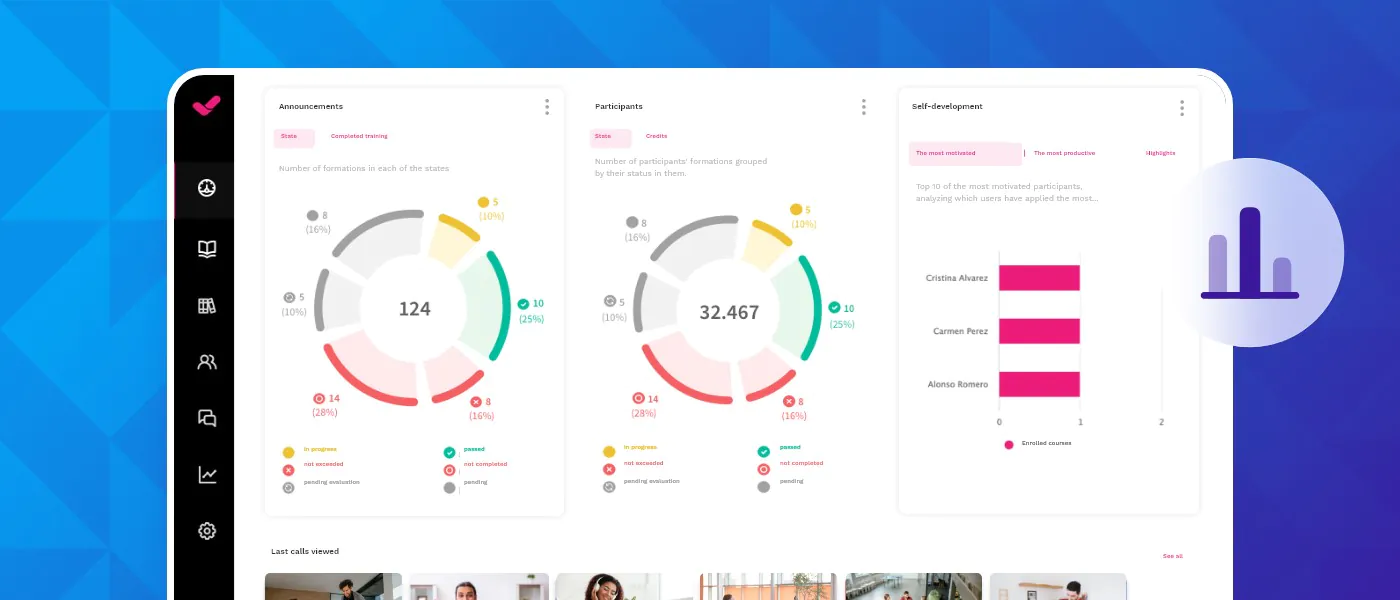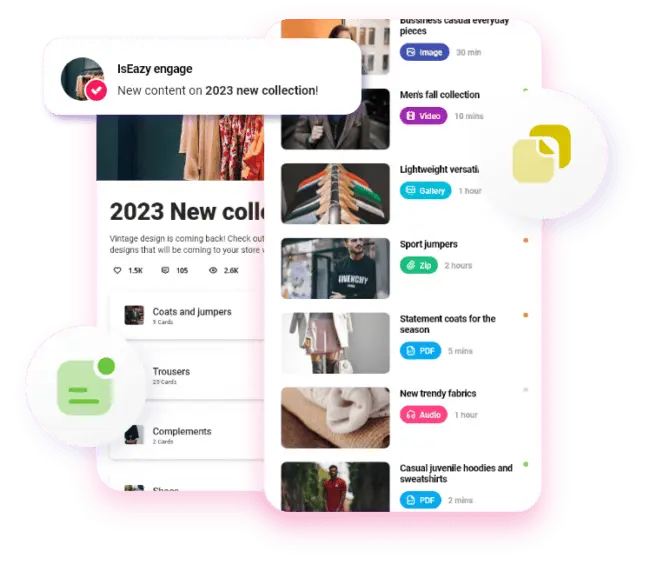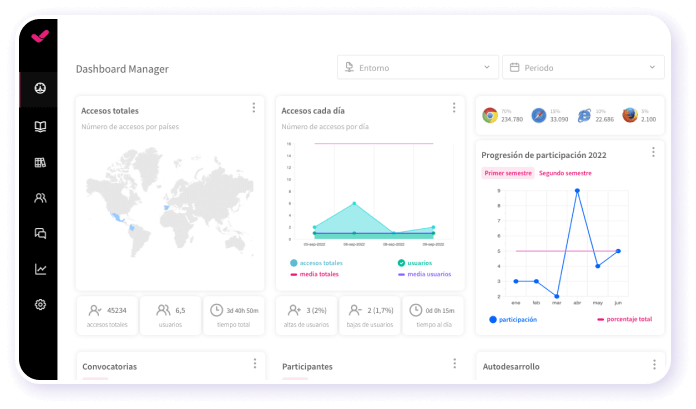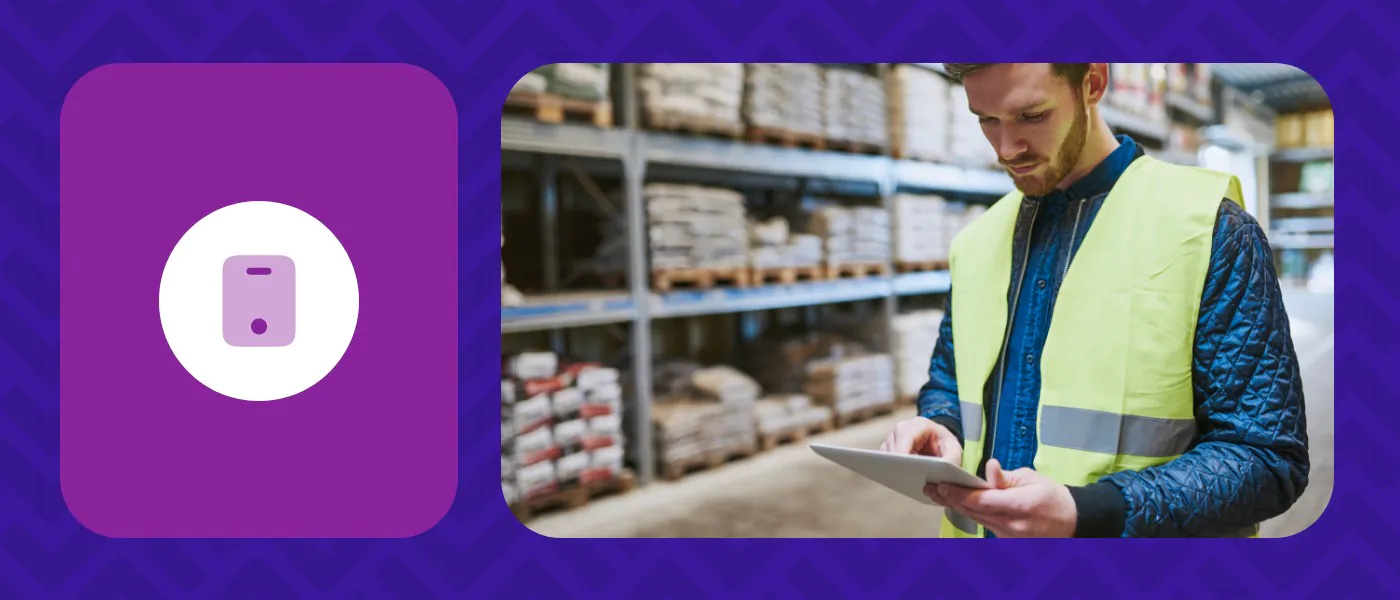
WHITEPAPER
How to take your in-person training online with the right authoring tool
February 18, 2025

Table of contents
In recent times formative assessment has been gaining ground as a key strategy to improve the teaching and learning process, both within the academic field and in corporate training.
This agile model allows instructors to make real-time adjustments to the teaching process, ensuring that any difficulties in learning are identified and corrected before they become an obstacle to students. In this article, we’ll explore how formative assessment works, its key benefits, and take a look at how to apply it effectively.
Formative assessment is the process of continuously monitoring learning, with two key objectives in mind: one, to measure student performance; and two, to gather real-time feedback to help improve the uptake of content. Unlike summative assessment – which occurs once at the end of a course or unit and aims to assign a final grade – formative assessment is integrated throughout the entire teaching process, allowing for pedagogical adjustments to be made along the way.
The approach is based on a range of active methodologies – such as problem-based learning, gamification and microlearning – and encourages students to get more involved in their own development. In addition, formative assessment can be applied in multiple contexts, from basic academic education to corporate training, and this makes it a crucial element for more effective and personalized learning.
The main function of formative assessment is to identify educational issues and opportunities for improvement within the learning process before the student reaches the end of the course or unit. Its biggest benefits include the following:
In the corporate world, formative assessment is essential for the proper development of soft skills and technical competencies, ensuring that employees develop skills in a way that is practical and applicable to their professional practice. Solutions such as LMSs (Learning Management Systems) and microlearning platforms help to facilitate this approach, making learning more dynamic and efficient.
Evaluating the success of your training program involves monitoring its progress and identifying areas for improvement. It allows you to see which parts of your content are working and which aren’t based on different metrics and demographics related to users, sessions, media, and beyond.
First and foremost, the evaluation of training is essential for measuring progress towards your training objectives. A well-considered training plan should be based around a set of goals that determine whether or not your program is successful and measuring your results against them is essential to see what value you are offering to your employees and the company as a whole.
It’s also useful for tackling common challenges in the learning and development industry like learner engagement; by monitoring your analytics you can see where these challenges are most prominent and in doing so, develop a plan to tackle them, make necessary improvements to your training, and improve your ROI (Return on Investment).
These assessments take place during the learning process, measuring student progress in real time and identifying areas for improvement. They are facilitated through interactions between the instructor and their audience.
During these interactions, instructors adopt a receptive and flexible attitude to cater to students’ needs, supporting the learning process with resources and tools for learning reinforcement.
They can be conducted using:
These assessments are conducted at the end of the teaching process and aim to reinforce previously acquired knowledge. They allow the audience to address specific doubts and enhance learning outcomes.
Some applications include:
This type of assessment aims to determine the scope of a training program and adapt its content accordingly. For instance, if learners achieved good results in a training module, more complex topics can be explored. In contrast, if students face difficulties, the training can be adjusted to address learning needs and contribute to more effective outcomes.
Common applications include:
If you want formative assessment to make a big contribution to learning, it’s essential to structure it strategically. The assessment process should be dynamic, continuous and adaptable to the changing needs of students or employees. Let’s take a look at some of the key practices that help ensure effective formative assessment.
Effective formative assessment goes beyond traditional written tests. Switching up assessment methods allow students to demonstrate their knowledge in more dynamic ways that apply practically to the job market. Self-assessment, for example, helps students to reflect on their own progress, while continuous feedback from instructors helps them to course-correct and reinforce good practices. Discover more about different learning styles in this helpful article.
LMS platforms, such as isEazy LMS, allow for the effortless implementation of multiple assessment methods, making it easier to personalize teaching and adapt it to different learning styles.
Student participation is a decisive factor for the success of formative assessment. In order to increase participation, it’s important to use methodologies that encourage active learning. Project-based learning, for example, allows students to apply theoretical concepts to practical challenges, giving them a chance to put their learning into practice.
Other powerful tools that help to promote interaction and consolidate knowledge include discussions, case studies and simulations. Social learning platforms can also be integrated into the process, allowing students to share experiences and reinforcing their collective progress.
Within the corporate environment, tools such as isEazy Engage help to create a dynamic, social and collaborative learning environment, promoting higher levels of engagement and enhanced knowledge retention.

Before applying any new assessment method, it’s important to know exactly what skills or knowledge students need to develop. Establishing clear, relevant success criteria allows both instructors and students to track progress accurately over time, ensuring that learning is properly aligned with the set objectives.
It’s also important for these objectives to be measurable, as checking whether or not they’ve been met will allow you to make continuous adjustments to the teaching process. Setting objectives with care will ensure that your formative assessment yields valuable data, helping to shape and improve learning over time.
Unlike traditional assessments, where students might receive feedback long after completing the activity, feedback from formative assessments needs to be constant and specific.
In order to be truly effective, it should also be focused and constructive. Ensure that you highlight strengths, suggest ways to improve, and encourage the student to continue evolving. Customizing feedback to the learner’s profile and individual needs will make the process even more efficient and motivating.
In the world of corporate training, platforms that offer real-time performance reporting make it easier to track learning. This feature enables managers to provide more accurate and relevant feedback.

Formative assessment transforms learning into a more dynamic and adaptable process, promoting continuous micro-adjustments and ensuring that students absorb knowledge more effectively. Below, we explore some of its key benefits:
In the world of education, teachers can use this approach to adjust methodologies based on student performance. In the corporate environment on the other hand, managers can guide employees onto learning paths that are more aligned with their individual needs. This model naturally favors upskilling and reskilling, helping to accommodate professional evolution in a strategic way.
Identifying and correcting errors early helps to prevent skills gaps. In academic teaching, this improves students’ understanding of content, while in the corporate world it helps managers to spot difficulties and offer specific training to improve employee performance. LMS platforms such as isEazy LMS allow for continuous progress monitoring, optimizing feedback and supporting professional development.

Formative assessment encourages the application of knowledge to real-world situations. In teaching, it promotes project-based learning, while in the corporate environment it strengthens the technical skills and soft skills essential for professional performance.
Detecting learning difficulties quickly prevents time and resources from being wasted on ineffective training. In the academic field, formative assessment allows for improved knowledge retention through small adjustments to the curriculum. In companies, it facilitates the creation of more strategic development plans, resulting in training that’s better aligned with market demands.
Offering ongoing support and providing personalized assessments boosts student confidence, encouraging them to continue learning. In this way the approach reduces the number of dropouts and improves knowledge retention, ensuring that students know how to apply their learning in practical situations.
Through the Business Intelligence Module in isEazyLMS, you can export and download a huge amount of data relating to the performance of both your content and learners.
But how can you evaluate the results of your training? There are various online tools which provide statistics and reports on your e-learning content. You can also include evaluations like self-assessments within the content itself.
A Learning Mangement System (LMS) can be incredibly valuable when it comes to diving deep into the effectiveness of your training. With this software, you can create, deliver, manage, and evaluate your training in a single online platform. Its evaluation capabilities are particularly extensive, allowing you to download reports that cover a wide range of variables and demographics.
isEazy LMS for example, features a dedicated module for reports and evaluations that allows both administrators and tutors to export and download data by user, session, geographical area, and beyond.
Now you understand some of the key metrics to consider, the first step to improving your training is evaluating them. Download the reports that apply to your training program and involve the relevant stakeholders in the process.
Next, use these results to identify areas for improvement based on the parts of your training with the least interactions and engagement. Make a note of how different factors influence these results too, from location to the devices used. You can dive deeper into the reasons behind these results by asking for feedback from users.
Use the metrics, in combination with the feedback you receive, to make changes and improvements to your training. At this point, you can also consider the latest trends in e-learning to really optimize your content and make sure it’s delivered in a way that resonates with modern learners. Microlearning, gamification and personalization of training are just a few examples.
Last but not least, it’s important to encourage ongoing feedback in relation to your training. Be sure to communicate the values of likes, saves, comments, and reviews to your employees and commit to a process of continuous improvement with their opinion at the center.
Discover isEazy LMS’ Business Intelligence Module and explore all the metrics you need to carry out a thorough learning assessment and take your training to the next level. Analytics are presented in a visual, user-friendly way that makes it easy to evaluate training and optimize your content based on data by person, department, geographic area, or company. Try it for free.
Formative assessment is an ongoing process that provides real-time feedback throughout an educational course, allowing for quick adjustments to learning. It can be applied during training to help personalize teaching. By contrast, summative assessment is carried out at the end of a course or program, and measures performance through specific tests and quantitative metrics. While formative assessment aims to improve learning, summative assessment seeks to validate and certify acquired knowledge.
LMS platforms such as isEazy LMS make it easy to track learner progress and deliver immediate feedback. Other tools you can use include interactive tests, gamification and microlearning, which help to make learning more dynamic and adaptable. Diagnostic assessments and hands-on activities can also be useful, allowing content to be adjusted according to learner needs.
If you want to successfully implement formative assessment within the corporate environment, you’ll need to define clear objectives, provide a range of assessment methods and encourage active participation. Immediate, personalized feedback will increase student engagement, while data analysis tools, such as isEazy LMS Business Intelligence, will help you to monitor employee progress and optimize training programs.
Yes. Applying formative assessment to online education allows you to continuously monitor student progress and tailor content to their needs. Resources such as interactive tests, automated feedback and discussion forums all help to make learning more dynamic. Additionally, the inclusion of detailed metrics and reports on LMS platforms makes it easier to optimize teaching and guarantee more effective training.
An effective analysis of the results should focus on detecting patterns and key areas for improvement. For example, a low level of participation may indicate a need for more interactive content, while recurring difficulties in specific modules may benefit methodological adjustments. isEazy LMS analytics reports allow you to visualize these trends and adapt your training programs accordingly.
WHITEPAPER
How can you improve learning assessment and tracking?
Measure the real impact of your training. Discover the next generation of learning platforms.
Download whitepaper



